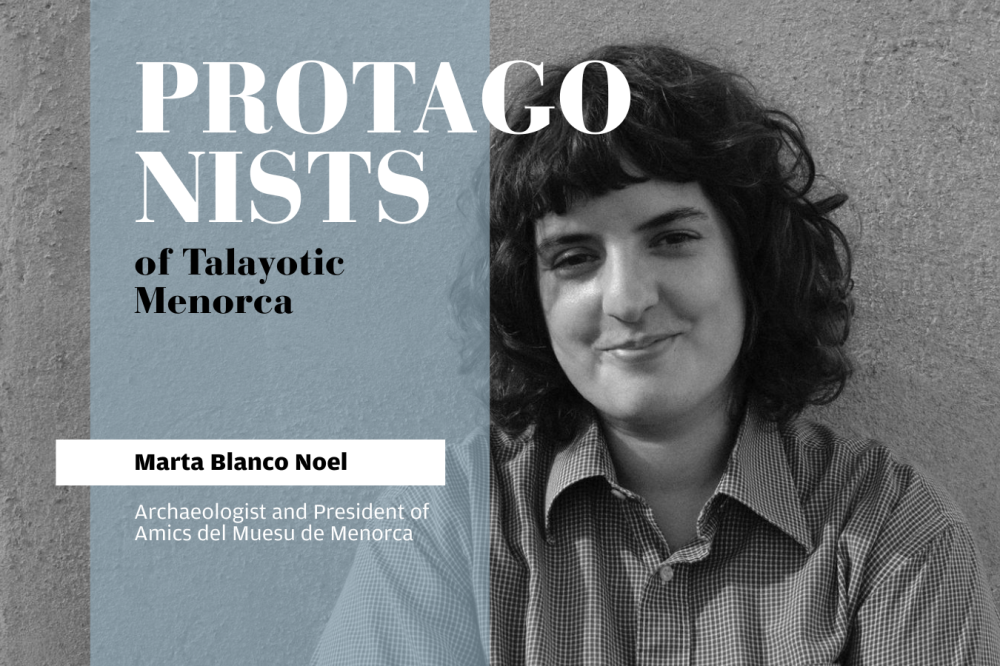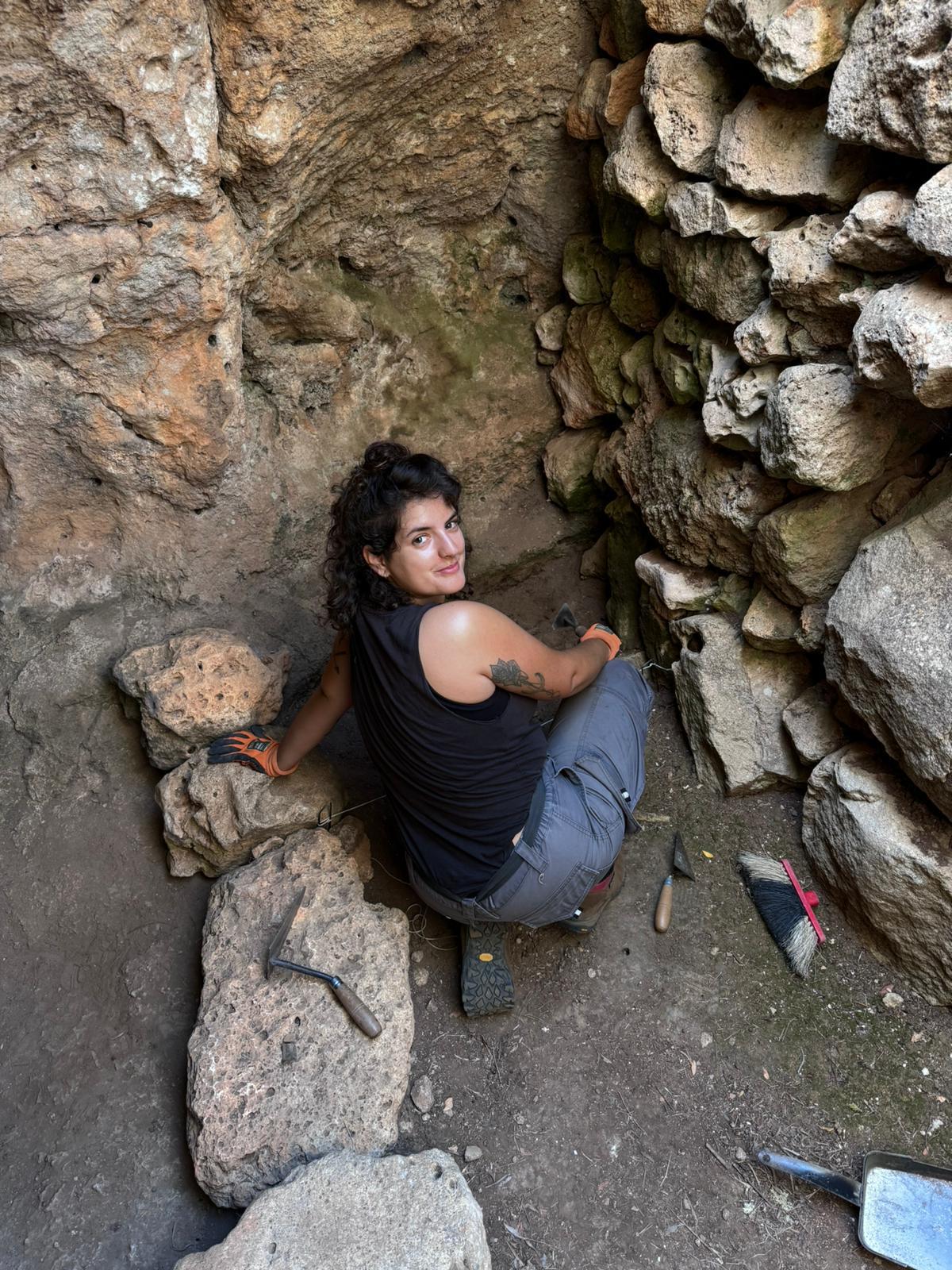
Marta Blanco Noel is a Catalan archaeologist who has been living in Manacor for the past six years. She began her History degree at the University of Barcelona and, after an Erasmus stay in Italy, completed her studies at the UOC and the University of Lleida. She is currently finishing her Master’s in Applied Classical Archaeology, Research and Transfer, jointly offered by the Universitat Rovira i Virgili, the Universitat Autònoma de Barcelona and the Catalan Institute of Classical Archaeology.
Her first steps in archaeology were in Menorca with
Amics del Museu, the association of which she is now president and with whom she excavates Structure 1 at Torre d’en Galmés. She is also a member of the
Menorca Archaeological Project, which studies the medieval Islamic reoccupation of the same site, where she serves as laboratory manager and field technician.
At the same time, she works as a technician on archaeological monitoring of construction projects and has co-founded La Tangenta, a cooperative project based in Manacor that develops cultural and educational initiatives with a critical perspective, linked to heritage, music, performing arts and participatory processes.
How did your relationship with Menorca begin?
I came to Menorca thanks to a friend, also an archaeologist, who put me in contact with the Amics del Museu de Menorca team. I had never been before and was truly amazed by the quality of preservation of the sites and the importance given to heritage.
In how many Talayotic sites in Menorca have you worked? Is there any intervention you consider particularly significant to better understand this culture?
I have taken part in archaeological excavations at Torralba d’en Salort and Torre d’en Galmés, with two different teams: Amics del Museu de Menorca and the Menorca Archaeological Project. However, Becatalaiotica has been the project that has given me the most global vision of Menorca’s sites, since we usually visit several to decide where the artistic interventions will be developed. It has been a real pleasure to discover them while reading articles and reports by colleagues who have excavated them. I don’t think there is one intervention more important or significant than the others; I like to think of them all as part of an integrated, global research that reveals different aspects of the same cultures.
You went from being a student and volunteer in excavation campaigns to dedicating your Master’s thesis to the combustion structures of Talayotic houses, the circles. What sparked your interest in this particular aspect?
I am finishing the Master’s in research and transfer in archaeology (URV, UAB and ICAC), but my intention is to continue researching combustion structures within domestic spaces. This interest arose both from the guidance of archaeologists from whom I have had the pleasure of learning — Carmen Lara, Carme Belarte and their research team — and from a reflection on our own everyday lives and environment. After all, if we almost always gather around a table to eat and drink, it is clear that what happens there matters.
Could you tell us a little more about the combustion structures you are studying? What information do they provide about daily life in the Talayotic period?
Combustion structures, kitchens and commensality practices can yield a huge amount of information: in dietary terms we can analyse animal bone remains and plant and seed remains that were consumed, the type of wood used as fuel and, therefore, the configuration of the landscape. Cooking and eating are imbued with cultural and symbolic elements, also providing valuable insights into contact with other cultures. Practices of food consumption and preparation leave behind material evidence — often ceramics and metal objects — that are fascinating to study. Even the morphology of hearths or ovens reveals the production and consumption needs of these communities.
You have recently been elected president of Amics del Museu de Menorca. How are you approaching this new challenge? What goals have you set?
I have taken over from Cecília Ligero, someone I greatly value both professionally and personally. I want to continue along the path set by Amics del Museu, while contributing all the ideas and energy I can. In addition to being an archaeologist, I am a co-founder of La Tangenta, a cultural management cooperative, and I am also part of cultural associations such as Neura in Manacor. All the work we have done in Mallorca, organising different types of social and cultural events with a critical perspective that enriches our community, is experience I believe I can bring to my role as president of Amics.
 What can you tell us about the Becatalaiotica Programme? How did the initiative come about and what impact has it had?
What can you tell us about the Becatalaiotica Programme? How did the initiative come about and what impact has it had?
Becatalaiotica began as an initiative of Amics del Museu de Menorca to offer guided tours of sites in a fun and original way, helping people discover this heritage. Over the years, the project has grown and later focused more on developing artistic interventions at sites — another form of outreach. Right now, we are in the process of rethinking the project, which will probably take shape as an artistic residency for creation and research… but I can’t reveal too much! We’ll share more soon. Personally, I would say this kind of initiative is vital to bring heritage closer to the general public. It is essential to create appealing options and offer different activities in spaces that are for everyone to enjoy.
Although the association’s main objective is heritage outreach among the local population, Becatalaiotica has taken Talayotic culture across Spain. How do you assess the outreach work being done from Menorca to the outside world?
It is extremely important to raise awareness of heritage externally, but this must always be accompanied by a realistic understanding of the territory’s capacity to host visitors. I believe that as a society we must learn to value, defend and appreciate things even if that does not necessarily mean benefiting from them. The outreach work carried out in Menorca so far has been a success, but it is also necessary to maintain a balance with the island’s capacity to welcome visitors so it does not become a social or ecological disaster. Ultimately, we must bear in mind that sites are part of a broader ecosystem and social fabric.
Beyond your role as archaeologist and researcher, you place great importance on drawing. What role do you think drawing plays in explaining and disseminating Talayotic heritage?
Drawing and artistic expression allow us to imagine realities we have not experienced. In a Talayotic context, where we have almost no written information, aside from the material record, it is a valuable mental exercise to illustrate what we have discovered through scientific findings. I believe it is fantastic to have archaeologists who can draw, interpret the information and then propose a representation of what has been found. The use of this type of image is increasingly common in outreach contexts, and I think it is an excellent way to engage a wider audience.
How do you think interest in Menorca Talayótica has evolved in recent years, especially after the World Heritage designation? Has the perception of the public or the institutions changed?
I think there had already been years of work to spread knowledge of heritage and reach different sectors of the population, both from the administration and from associations such as Amics del Museu de Menorca. Achieving World Heritage status has been a step forward for the conservation and protection of the archaeological and historical complex, but it is not an end point. At the institutional level, policies must continue to be developed to protect heritage and not put it at risk, and support must continue for associations and individuals who dedicate their efforts to this work.
What challenges do you think archaeological research in Menorca currently faces?
I think the main challenge in research is to keep encouraging the development of projects that have the possibility of publishing their results. An interesting approach in this respect is to generate projects that allow us to compare and understand the relationship between Menorca and Mallorca in the past, bringing together research groups that can work in both areas.
What role do you think young people should play in the conservation and dissemination of island heritage?
It is essential to involve young people in these areas, since if we transmit respect for heritage, it will endure. It is important to give them space to do so, to propose activities that are attractive and, above all, to give them the opportunity to decide how they want to approach heritage and what activities they would like to develop.
To finish, three quick questions…
A Menorcan site that inspires you: Torrellafuda.
A discovery that has marked your career: The most recent one, a hearth in Structure 1 at Torre d’en Galmés, which we will excavate in the next campaign.
A book or author essential for understanding Menorcan prehistory: I would go for books that bring together articles by different researchers, such as
“Cercles, l’hàbitat protohistòric de l’illa de Menorca”, coordinated by Octavio Torres and Amalia Pérez-Juez. I think they give visibility to different studies carried out on the same subject.